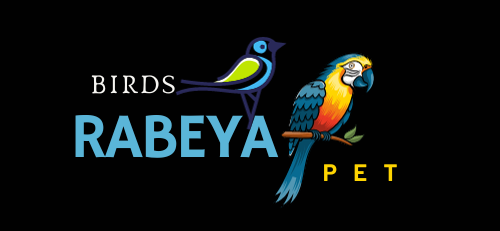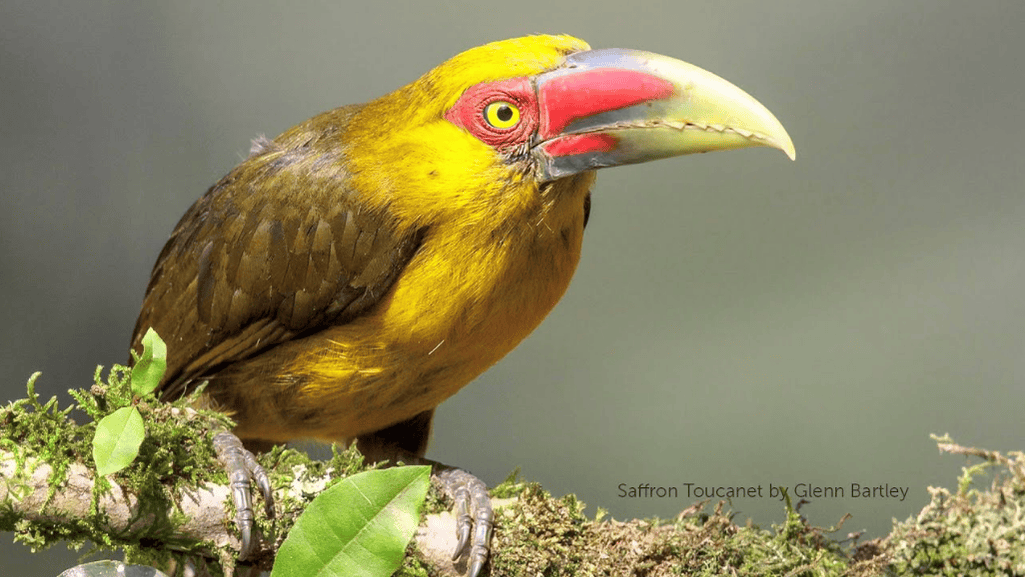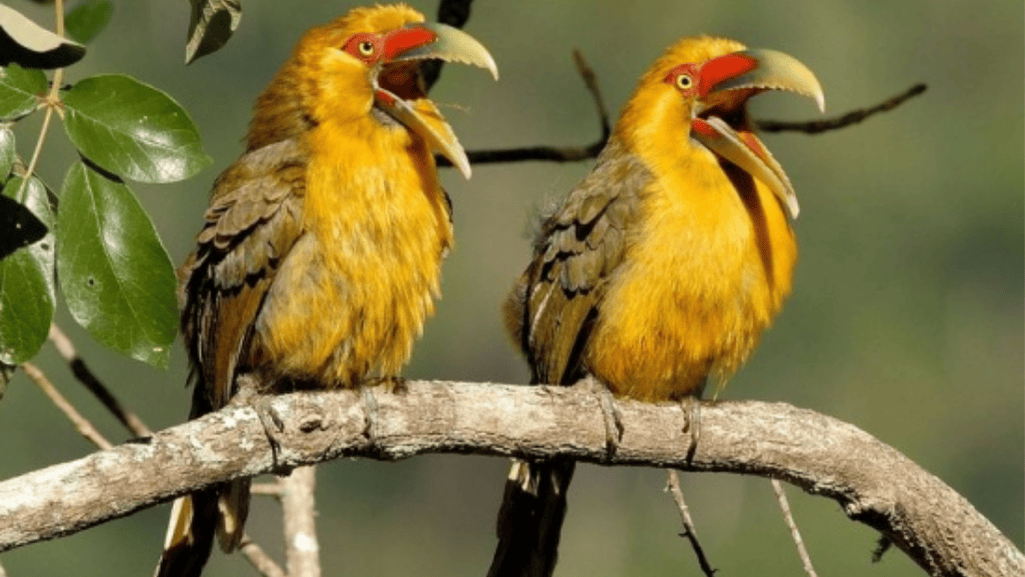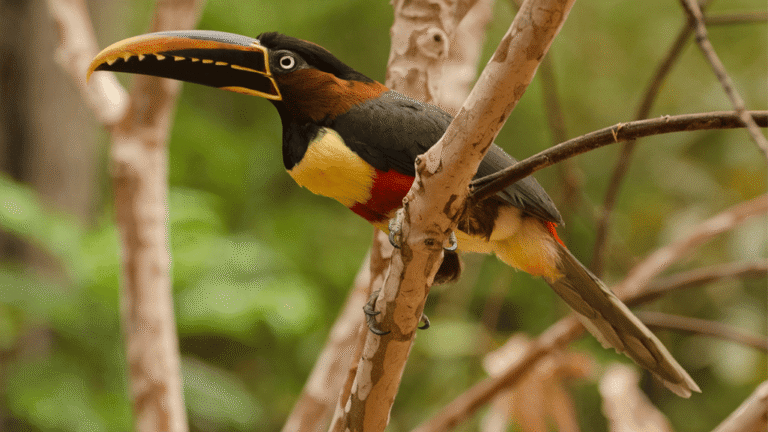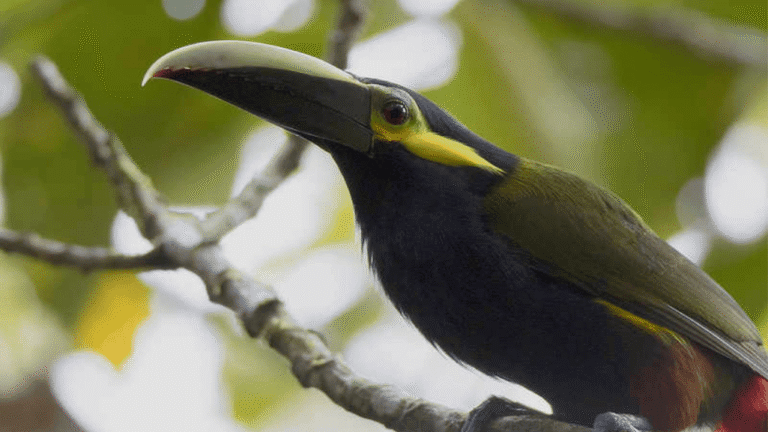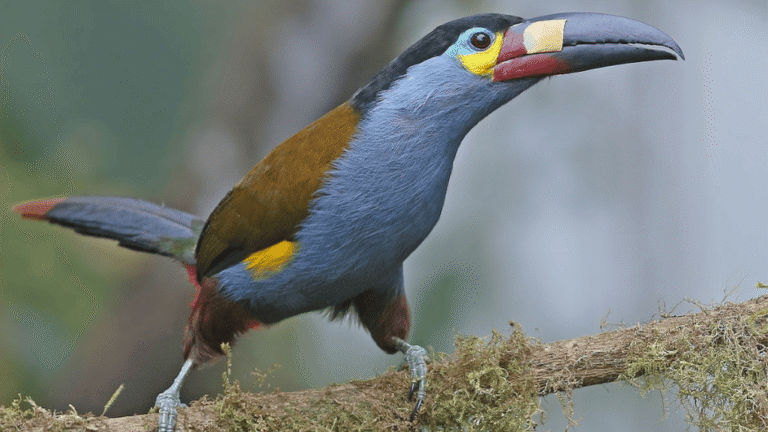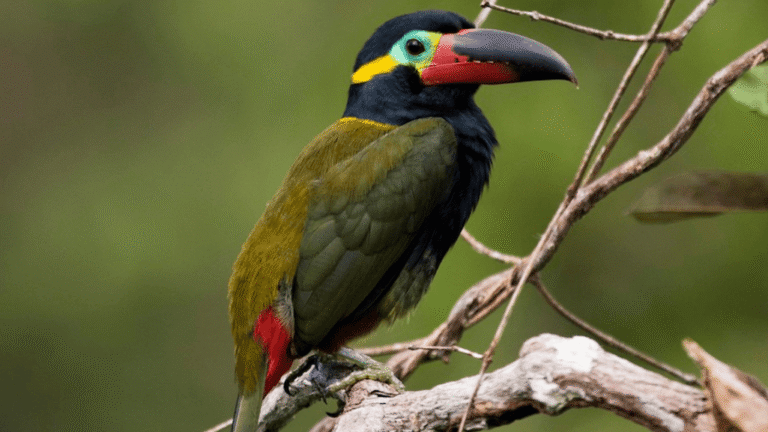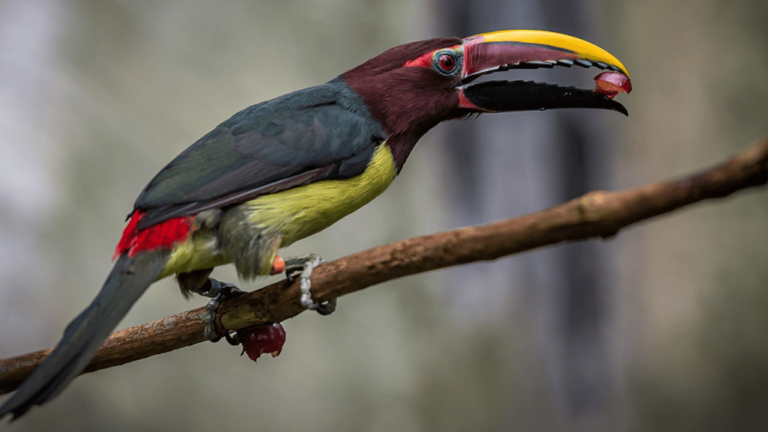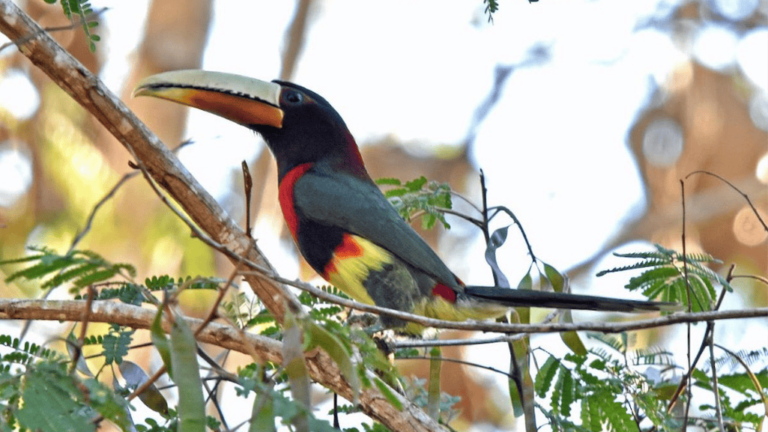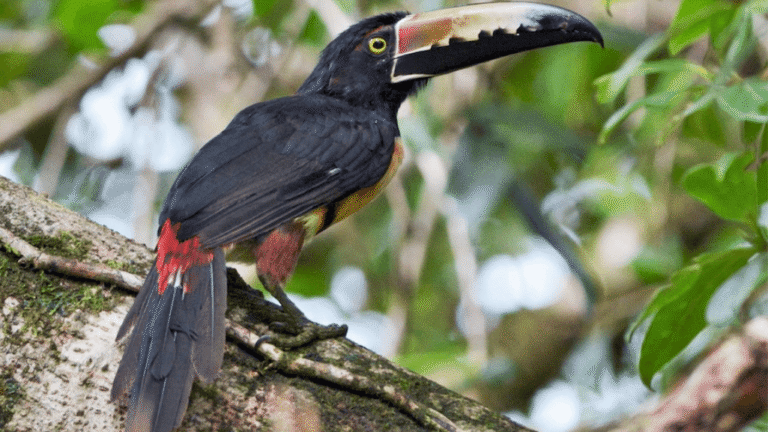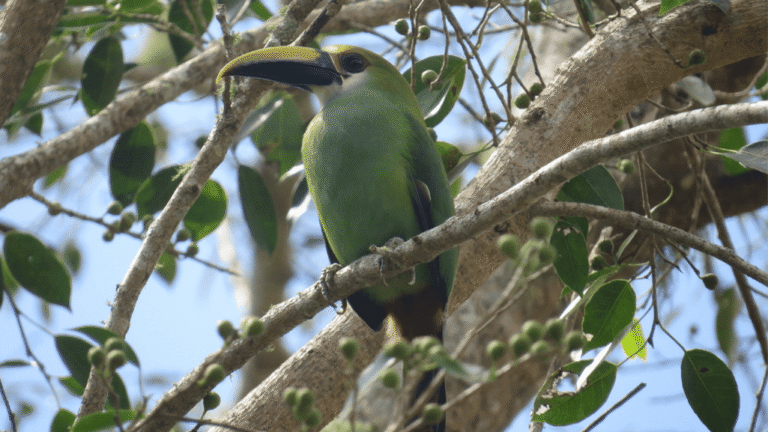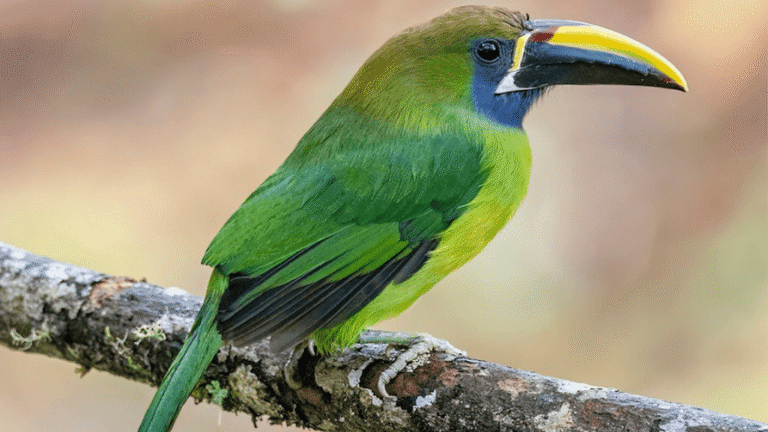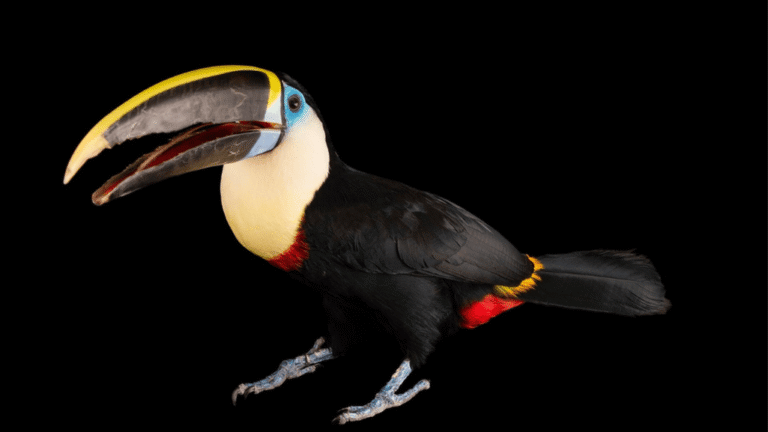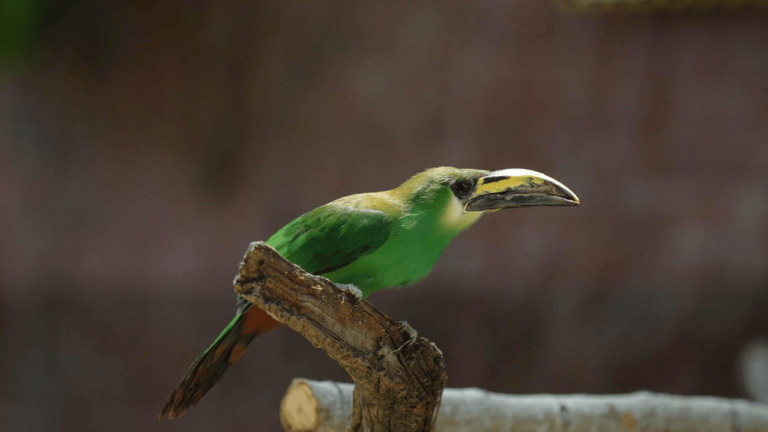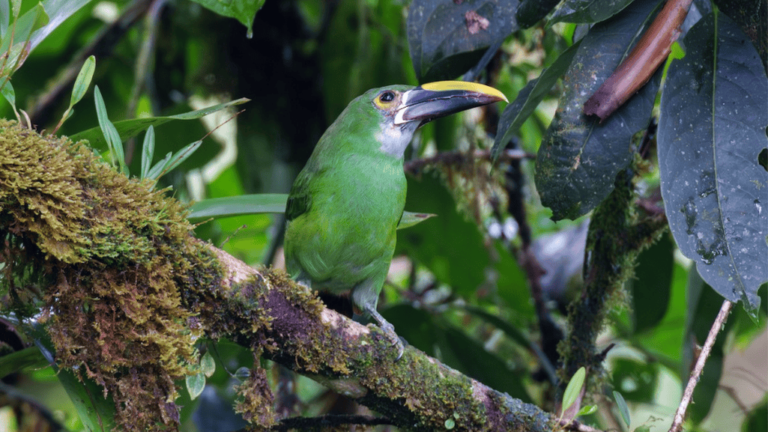The Saffron Toucan, scientifically known as Pteroglossus bailloni, is a medium-sized to large bird with a strikingly large and colorful bill. It is instantly recognizable and commonly found in tropical and montane rainforests of South America, ranging from Brazil to northern Argentina. The Saffron Toucanet belongs to the family Ramphastidae, which includes a total of 41 species in 6 genera. It is classified as an endangered species, with three other species being categorized as near threatened.
Key Takeaways
- The Saffron Toucanet, Pteroglossus bailloni, is a medium-sized to large bird with a colorful bill.
- It is commonly found in tropical and montane rainforests of South America.
- The Saffron Toucanet is part of the Ramphastidae family, which includes 41 species in 6 genera.
- It is listed as an endangered species, with three other species categorized as near threatened.
Evolution and Systematics of Toucans
Toucans, including the Saffron Toucanet, are a unique group of birds that have evolved from a common ancestor with barbets and are closely related to woodpeckers and hornbills. The speciation of toucans is believed to have occurred during the Pleistocene glaciations and interglaciations in the Amazonian region. This rapid formation and disappearance of new biomes enhanced speciation rates, leading to the diversity of toucan species we see today. There are a total of 41 species in 6 genera within the Ramphastidae family.
Toucan Evolution and Relationships
Toucans, barbets, woodpeckers, and hornbills belong to the order Piciformes, sharing a common evolutionary history. With their distinctive features and behavior, toucans have evolved a unique niche within this diverse group of birds.
The family Ramphastidae, which encompasses toucans, comprises six genera: Andigena, Aulacorhynchus, Baillonius, Pteroglossus, Selenidera, and Ramphastos. Each genus encompasses different species, displaying specific adaptations and characteristics.
Toucan Speciation
During the Pleistocene epoch, the Amazonian region experienced dynamic changes in climate, leading to the formation and disappearance of various biomes. These shifts in environmental conditions created opportunities for rapid speciation in toucans.
The isolation of toucan populations in different regions with specific ecological conditions contributed to their divergence and subsequent speciation. The development of new habitats and the availability of distinct resources led to the evolution of unique traits and adaptations among different toucan lineages.
| Toucan Genus | Number of Species |
|---|---|
| Andigena | 5 |
| Aulacorhynchus | 13 |
| Baillonius | 1 |
| Pteroglossus | 14 |
| Selenidera | 5 |
| Ramphastos | 3 |
Table: Toucan Genera and Species
The table above illustrates the number of species within each toucan genus. With 41 species spread across these six genera, toucans exhibit remarkable diversity in appearance, behavior, and ecological roles.
Physical Characteristics of Toucans
Toucans are fascinating birds known for their vibrant plumage and distinctive physical features. The most prominent characteristic of toucans is their unusually long and bulky bill, which is lightweight despite its size. The toucan’s bill is downcurved with serrated edges, allowing it to easily grasp and manipulate food. This bill is not only a feeding tool but also serves various other functions, including thermoregulation and attracting mates.
The plumage of toucans is another striking feature, with bright colors and intricate patterns. Different toucan species display a wide range of hues, including shades of yellow, red, blue, and black. The vibrant plumage serves as a visual display during courtship rituals or for species recognition within their social groups.
Another fascinating aspect of toucan anatomy is their zygodactylous feet. This means that toucans have two toes projecting forward and two toes pointing backward, providing them with enhanced gripping ability. These specialized feet help toucans navigate through the tree branches and move with agility in the forest canopy.
Toucan Bill
The toucan bill is a remarkable adaptation that sets these birds apart from other avian species. Not only does it assist in feeding, but it also plays a crucial role in thermoregulation. The bill is richly vascularized, allowing for efficient heat exchange. When the weather is warm, toucans can dissipate excess heat by increasing blood flow to the bill. Conversely, in colder conditions, they minimize heat loss by reducing blood flow.
Toucan Plumage
The colorful plumage of toucans has several functions, including camouflage, species recognition, and courtship displays. The vibrant colors and intricate patterns help them blend into the forest canopy, making it easier to evade predators. Additionally, the unique plumage patterns act as a visual cue for individual recognition within toucan social groups. During courtship displays, male toucans often exhibit elaborate feather movements and vocalizations to attract potential mates.
Zygodactylous Feet
The zygodactylous feet of toucans are well-suited for their arboreal lifestyle. This foot structure provides them with a strong grip, enabling them to maneuver through the tree branches with agility. The toes’ backward-pointing arrangement allows toucans to perch securely on even the thinnest branches, ensuring their stability while feeding or resting.
| Toucan Physical Characteristics | Description |
|---|---|
| Bill | The toucan bill is long, bulky, downcurved, and serrated. It is lightweight despite its size and serves multiple functions, including feeding, thermoregulation, and attracting mates. |
| Plumage | Toucans have brightly colored plumage with intricate patterns. The vibrant colors serve various purposes, such as camouflage, species recognition, and courtship displays. |
| Feet | Toucans have zygodactylous feet, with two toes projecting forward and two toes pointing backward. This foot structure provides them with a strong grip and agility for navigating the forest canopy. |
Distribution and Habitat of Toucans
Toucans are fascinating and colorful birds that are mainly found in the Neotropics, a region spanning most of tropical South America, from Mexico to northern Argentina. They have adapted to a wide range of habitats within this region, showcasing their remarkable versatility and adaptability.
Most toucan species are known as canopy specialists, meaning they prefer to inhabit the upper levels of tropical or montane rainforests. The dense foliage and abundance of fruit in the canopy provide the ideal environment for these charismatic birds. Their unique bill shape and size allow them to reach for high-hanging fruits, which form a significant portion of their diet.
Some toucan species, such as the toucanets and mountain toucans, have home ranges that extend to higher elevations, where they can be found in cloud forests and montane habitats. These birds have adapted to cooler temperatures and slightly different ecological conditions compared to their counterparts in lowland rainforests.
On the other hand, riverine specialists like the toco toucan thrive in habitats near rivers and bodies of water. These toucans have specialized adaptations that enable them to find food and nest in close proximity to water sources.
Besides rainforests and riverine habitats, toucans can also be found in other types of environments. They have been observed in palm savannas, where they take advantage of the abundant palm fruits, as well as in secondary vegetation, including regenerating forests and disturbed areas.
Overall, the distribution and habitat of toucans reflect their incredible ability to adapt to diverse ecosystems, showcasing their importance as ecological indicators and keystone species in the Neotropics.
Toucan Distribution by Country (Number of Species)
| Country | Number of Toucan Species |
|---|---|
| 1. Brazil | 14 |
| 2. Peru | 12 |
| 3. Colombia | 11 |
| 4. Ecuador | 9 |
| 5. Bolivia | 8 |
Table: Toucan distribution by country. The Neotropics host a rich diversity of toucan species, with Brazil being home to the highest number of species, followed by Peru, Colombia, Ecuador, and Bolivia.
Image: A colorful toucan perched in the tropical rainforest canopy. Toucans are canopy specialists, inhabiting the upper levels of the forest where they forage for fruits.
Behavior and Feeding Ecology of Toucans
Toucans are social birds that exhibit interesting behavioral patterns in their foraging and feeding activities. They often form small family groups or flocks and are known to be social but not intensely sociable. Toucans prefer loose group formations rather than tight clusters.
Toucans have unique feeding behaviors that are a result of their specialized bill and dexterity. Their diet primarily consists of fruits, which make up the majority of their food intake. They have a keen ability to reach high-hanging fruits and probe into nests or tree crevices with their dexterous bills, allowing them to access food sources that are otherwise challenging to reach for other birds.
In addition to fruits, toucans supplement their diet with insects, small mammals, and even bird eggs. This diverse food intake ensures that they meet their nutritional needs and adapt to the available resources in their habitats.
Toucans also play a vital role in the ecosystem through seed dispersal. After consuming fruits, they regurgitate larger seeds and excrete smaller seeds. This process aids in the dispersal of seeds across the tropical forests, contributing to the regeneration and biodiversity of these ecosystems.
Toucan Behavior and Foraging:
- Toucans form small family groups or flocks.
- They prefer loose group formations rather than tight clusters.
- Toucans have a unique feeding behavior due to their specialized bill.
- Their diet primarily consists of fruits, supplemented with insects, small mammals, and bird eggs.
- Toucans use their dexterous bill to reach high-hanging fruits and investigate nests or tree crevices.
Toucan Vocalization:
 Toucans are known for their distinctive vocalizations that include a variety of calls and sounds. They use vocalization as a means of communication within their social groups, signaling their presence, defending their territory, and attracting mates. Their calls range from soft, melodic notes to loud and distinctive vocalizations that can be heard over long distances.
Toucans are known for their distinctive vocalizations that include a variety of calls and sounds. They use vocalization as a means of communication within their social groups, signaling their presence, defending their territory, and attracting mates. Their calls range from soft, melodic notes to loud and distinctive vocalizations that can be heard over long distances.
Toucan Diet:
| Primary Food Source | Supplementary Food Sources |
|---|---|
| Fruits | Insects |
| Small mammals | |
| Bird eggs |
The image above captures the essence of toucan behavior and foraging, showcasing their dexterous bills and their ability to reach high-hanging fruits.
Thermoregulation and Adaptations of Toucans
 Recent studies have revealed fascinating insights into the thermoregulation abilities and adaptations of toucans, including the Saffron Toucanet. These magnificent birds possess a remarkable feature that sets them apart from other avian species: their large bills. It turns out that the toucan bill serves a dual purpose, not only as a striking visual characteristic but also as an ingenious temperature regulation system.
Recent studies have revealed fascinating insights into the thermoregulation abilities and adaptations of toucans, including the Saffron Toucanet. These magnificent birds possess a remarkable feature that sets them apart from other avian species: their large bills. It turns out that the toucan bill serves a dual purpose, not only as a striking visual characteristic but also as an ingenious temperature regulation system.
The toucan bill is composed of a fine network of blood vessels, which play a crucial role in the bird’s ability to adjust its internal body temperature. This adaptation allows toucans to respond effectively to changes in weather conditions and withstand the varying environmental temperatures of their habitats.
By altering the blood flow within the bill, toucans can regulate the amount of heat exchange that occurs. During hot weather, the increased blood flow can help dissipate excess heat, keeping their bodies cool. Conversely, in colder temperatures, toucans can reduce blood flow to conserve heat and maintain a stable body temperature.
This unique thermoregulation mechanism, combined with other adaptations, enables toucans to thrive in diverse environments. Their ability to adjust their body temperature contributes to their survival and allows them to traverse a range of habitats, from tropical rainforests to montane regions.
Adaptability to Changing Climate
The thermoregulatory properties of the toucan bill provide an important advantage in the face of climate change and shifting environmental conditions. As the earth’s climate continues to fluctuate, toucans are better equipped to cope with temperature variations, ensuring their resilience and survival in a changing world.
Furthermore, the adaptations exhibited by toucans extend beyond thermoregulation. Their zygodactylous feet, with two toes facing forward and two toes pointing backward, enhance their agility and enable them to navigate the complex forest canopy with ease. This unique foot structure allows toucans to grasp branches securely and maintain balance while exploring their surroundings.
Overall, the thermoregulatory capabilities and remarkable adaptations of toucans, such as the Saffron Toucanet, demonstrate their remarkable ability to thrive in diverse ecosystems. These avian wonders continue to captivate scientists and nature enthusiasts alike, showcasing the incredible diversity and ingenuity found in the natural world.
Conservation Status and Threats to Toucans
The Saffron Toucanet, along with other toucan species, is currently facing significant conservation challenges primarily due to habitat loss and fragmentation. The destruction and degradation of their natural habitats have a detrimental effect on the population numbers of toucans, including the endangered Saffron Toucanet.
Toucans play a crucial role in maintaining ecosystem balance through their seed dispersal activities. As they traverse the canopy, consuming fruits and seeds, they help regenerate and diversify tropical forests. However, habitat loss disrupts this process and leads to a decline in biodiversity.
Conservation organizations and researchers are working tirelessly to protect the habitats of toucans and raise awareness about the importance of these charismatic birds in ecosystem functioning. Efforts are focused on implementing sustainable land and forest management practices, as well as advocating for the preservation and restoration of critical toucan habitats.
Endangered Toucan Species
Several toucan species, including the Saffron Toucanet, are classified as endangered or near threatened. The populations of these species are declining due to the combined effects of habitat loss, illegal pet trade, and climate change. Without immediate action, these magnificent birds could face the risk of extinction.
Here is a list of endangered toucan species:
- Red-billed Toucan (Ramphastos tucanus)
- Gould’s Toucanet (Aulacorhynchus prasinus)
- Channel-billed Toucan (Ramphastos vitellinus)
Toucan Conservation Efforts
Conservation initiatives are vital for protecting toucan populations and their habitats. These efforts focus on:
- Habitat preservation: Establishing protected areas and nature reserves to safeguard toucan habitats from deforestation and development.
- Community involvement: Engaging local communities in conservation activities to foster sustainable practices and promote the value of toucans as indicators of forest health.
- Anti-trafficking measures: Combating the illegal pet trade by implementing stricter regulations and raising awareness about the negative impacts on toucan populations.
- Scientific research: Conducting studies on toucan ecology and behavior to gain a better understanding of their ecological requirements and inform conservation strategies.
By prioritizing toucan conservation efforts, we can ensure the survival of these stunning birds and protect the delicate balance of our ecosystems.
Conclusion
The Saffron Toucanet, Pteroglossus bailloni, is a captivating bird species that can be found in the lush tropical and montane rainforests of South America. Alongside other toucan species, it plays a vital role in the dispersal of seeds and the regeneration of forest ecosystems. However, these remarkable birds face numerous threats, most notably habitat loss, which has led to a decline in their populations.
In order to safeguard the future of the Brazilian Toucanet and other South American birds, it is imperative that conservation efforts are implemented and awareness is raised. Protecting their habitats and ensuring sustainable forest management practices are essential steps in preserving these unique and colorful species. By doing so, we can ensure that future generations have the opportunity to appreciate and marvel at the beauty of these incredible birds.
Toucanet conservation efforts are multifaceted and require collaboration between conservation organizations, researchers, local communities, and policymakers. By working together, we can create a sustainable future for the Brazilian Toucanet and other South American birds, safeguarding their habitats and ensuring their survival. Let us strive to protect and cherish these magnificent creatures for generations to come.
FAQ
What is the scientific name of the Saffron Toucanet?
The scientific name of the Saffron Toucanet is Pteroglossus bailloni.
Where can the Saffron Toucanet be found?
The Saffron Toucanet is commonly found in tropical and montane rainforests of South America, ranging from Brazil to northern Argentina.
How many species are there in the Ramphastidae family?
The Ramphastidae family consists of a total of 41 species in 6 genera.
What is the significance of the bill in toucans?
The bill of toucans, including the Saffron Toucanet, is downcurved with serrated edges and a bristly or brushy tongue. It is lightweight despite its size and helps them reach high-hanging fruits and probe into nests or tree crevices.
Where are toucans mainly found?
Toucans are mainly found in the Neotropics, with their distribution spanning most of tropical South America, from Mexico to northern Argentina.
What do toucans primarily feed on?
Toucans primarily consume fruits, supplemented with insects, small mammals, and bird eggs. They also play a crucial role in seed dispersal, aiding in the regeneration of tropical forests.
How do toucans regulate their body temperature?
Recent studies have shown that the large bill of toucans, including the Saffron Toucanet, serves as an efficient temperature regulation system. The bill is laced with a fine network of blood vessels that allow toucans to adjust their internal body temperature by altering the blood flow in response to weather conditions.
What are the conservation status and threats to toucans?
Toucans, including the Saffron Toucanet, are facing conservation challenges due to habitat loss and fragmentation. Efforts are being made to protect their habitats and raise awareness about their importance in ecosystem functioning.
What efforts are being made for toucan conservation?
Conservation organizations and researchers are actively working towards conserving toucan populations and their habitats to ensure their survival.

